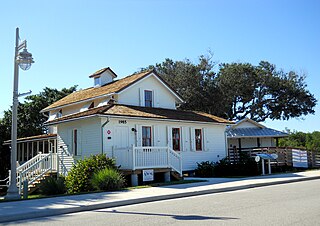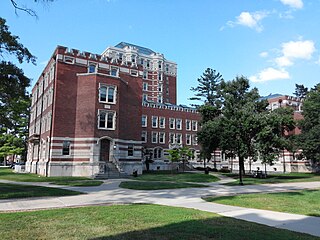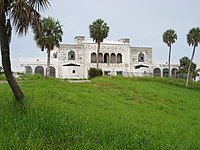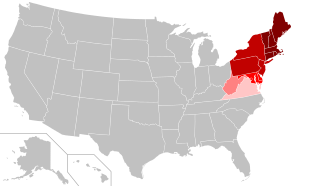
St. Johns County is a county of the U.S. state of Florida. As of the 2010 United States Census, the county's population was 190,039. The county seat and largest incorporated city is St. Augustine. St. Johns County is part of the Jacksonville metropolitan area.
College of St. Joseph is a private, residential, liberal arts Catholic college in Rutland, Vermont. It occupies a 117 acres (0.47 km2) wooded campus. Although the college is accredited by the New England Commission of Higher Education, it was placed on probation in August of 2018 because the college has experienced significant financial challenges.

This article is about the college in Michigan. For the other colleges, see Aquinas College.
The University of Albuquerque was a Catholic liberal arts university in Albuquerque, New Mexico, which closed in 1986. Its former campus on Albuquerque's West Side now houses St. Pius X High School, a Catholic high school.

The Sisters of St. Joseph, also known as the Congregation of the Sisters of St. Joseph and abbreviated C.S.J. or S.S.J., is a Roman Catholic religious congregation of women founded in Le Puy-en-Velay, France, in 1650. This Congregation, named for Saint Joseph, has approximately 14,000 members worldwide: about 7,000 in the United States; 2,000 in France; and are active in fifty other countries.

Ballyboden is a locality within the suburb of Rathfarnham in South Dublin, at the foot of the Dublin Mountains between Whitechurch, Ballyroan and Knocklyon. It is a townland in the civil parish of Rathfarnham in the Barony of Uppercross.

North Campus is a residential section of Cornell University's Ithaca, New York campus. It primarily houses freshmen. North Campus offers programs which ease the transition into college life for incoming freshmen. The campus offers interactions with faculty and other programs designed to increase interaction among members of the freshman class. North Campus is part of Cornell's residential initiative.
George Aloysius Carrell, S.J. was an American prelate of the Roman Catholic Church who served as the first bishop of the Diocese of Covington, Kentucky from 1853 until his death in 1868.

Tuckahoe, also known as the Leach Mansion or as the Mansion at Tuckahoe, is an historic home located at 1921 North East Indian River Drive in Jensen Beach, Martin County, Florida. The name was thought to be a Native American word for "welcome". It is inside the present day Indian RiverSide Park and is atop the Mount Elizabeth Archeological Site, which was added to the National Register of Historic Places on September 14, 2002.

Saint Raphael Academy is a Roman Catholic, coeducational, college preparatory school in Pawtucket, Rhode Island, USA. It was founded in the tradition of Saint John Baptist de Lasalle and rooted in the Holy Gospel of Jesus Christ. It is located in the Roman Catholic Diocese of Providence.

St. Joseph Academy Catholic High School is a private Catholic high school in St. Augustine, Florida. It is located in and administered by the Roman Catholic Diocese of St. Augustine. The oldest Catholic high school in Florida, it was founded in 1866.
Known for beautiful beaches, nature preserves and parks, Hutchinson Island consists of two barrier islands on the coast of Martin, St. Lucie, and Indian River counties, Florida. The two islands are separated by the Fort Pierce Inlet and are known as North Hutchinson Island and South Hutchinson Island. North Hutchinson Island is divided into two counties - Indian River County and St. Lucie County. The Indian River county portion of North Hutchinson Island which extends to the Sebastian Inlet is sometimes called Orchid Island, although it is not a separate island. See the Wikipage for North Hutchinson Island for more information.

The Armed Forces Medical College (AFMC) is a military medical college in Dhaka Cantonment, Dhaka, Bangladesh. It is run by the Military of Bangladesh and is under the Ministry of Defense of Bangladesh. A Major General of Bangladesh Army's Medical Corps is the Commandant of the College. It has two types of students: Medical Cadets and Army Medical Corps Cadets. AFMC cadets can become civilian doctors after completing the MBBS course, but AMC cadets should join the Army Medical Corps (AMC) of the Bangladesh Army.

Mount Saint Mary College in Hooksett, New Hampshire was a Roman Catholic college for women founded in 1934 by the Sisters of Mercy. The college was situated on a 550-acre (220 ha) campus approximately 60 miles (97 km) northwest of Boston. It ceased operations in 1978 due to the increasing trend away from single sex higher education which in turn led to a decline in enrollment from a high of about 500 students to just under 200 at the time of the closing. This decline eventually was the cause of financial difficulties from which the school never recovered.

The Jensen Beach Christian Church, originally known as the Jensen Union Church, is an historic church building located at 1890 N.E. Church Street in Jensen Beach, Florida. Built in the Gothic Revival style between 1910 and 1912 of site manufactured concrete blocks cast to look like stones, it was designed to serve the needs of local Protestants. Its pulpit and pews, which are still in use, were donated by Henry Morrison Flagler, the developer of the Florida East Coast Railway, whose mainline still runs through Jensen Beach less than a block west of the church.

The Capt. Henry E. Sewall House is an historic wooden house now located in Indian RiverSide Park in Jensen Beach, in Martin County, Florida. Local pioneer and developer Capt. Henry E. Sewall built it in 1889 at the southern tip of Sewall's Point, the peninsula and town which bear his family name. When Capt. Sewall became the postmaster of Sewall's Point, the house served also as the Sewall's Point post office. Next to the house Capt. Sewall also built a freight dock that extended into the St. Lucie River along with a storage building at its end.

Jewett House is a nine-story Tudor-style dormitory on the campus of Vassar College in the town of Poughkeepsie, New York. Built in 1907 to accommodate increasing demand for residential space, the dorm was designed by Vassar art professor Lewis Pilcher of the architectural firm Pilcher and Tachau. Early reviews looked unfavorably upon Jewett, even dubbing it "Pilcher's Crime" and by 2002, a host of issues plagued the dorm, leading to a $21 million renovation. Up to 195 students of any gender or class year may live in Jewett, which has been purported to be haunted by several different ghosts during its existence.




















